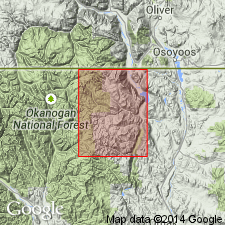
- Usage in publication:
-
- Toats Coulee magma series [informal]
- Modifications:
-
- Named
- Dominant lithology:
-
- Granodiorite
- Tonalite
- AAPG geologic province:
-
- Okanogan province
Summary:
/Toats Coulee magma series [informal]. Mapped in Toats Coulee Creek region, Okanogan Range, Washington. Includes: Douglas Mountain Tonalite Porphyry, Sinlahekin Tonalite, Tillman Mountain Tonalite, Loomis granodiorite, and Sarsapkin Tonalite (all new). Major units in series are Loomis granodiorite and Tillman Tonalite. All members of Toats Coulee magma series have textures that commonly are considered to be evidence for magmatic crystallization. Age is Late Triassic, based on radiometric (K-Ar, hornblende) age of 194 +/-6 Ma of Loomis granodiorite (citing Rinehart and Fox [1972]); since various members are gradational among themselves, this age applies to series. [Age is Early Jurassic, based on 1983 DNAG Geologic Time Scale and 1986 USGS Geologic Time Chart.]
Type locality not stated by author. Named from Toats Coulee [Creek], in T. 39 and 40 N., R. 23 E., Okanogan Co., WA.
["Toats Coulee magma series" considered informal. Term "Series" is applied formally only to chronostratigraphic units (ACSN, 1961, 1970; NACSN, 1983, 2005, 2021). US geologic names lexicon (USGS Bull. 1520, p. 309-310) lists both Toats Coulee Magma Series and Toats Coulee Group (explanation not given).]
Source: GNU records (USGS DDS-6; Menlo GNULEX); US geologic names lexicon (USGS Bull. 1520, p. 309-310).
For more information, please contact Nancy Stamm, Geologic Names Committee Secretary.
Asterisk (*) indicates published by U.S. Geological Survey authors.
"No current usage" (†) implies that a name has been abandoned or has fallen into disuse. Former usage and, if known, replacement name given in parentheses ( ).
Slash (/) indicates name conflicts with nomenclatural guidelines (CSN, 1933; ACSN, 1961, 1970; NACSN, 1983, 2005, 2021). May be explained within brackets ([ ]).

